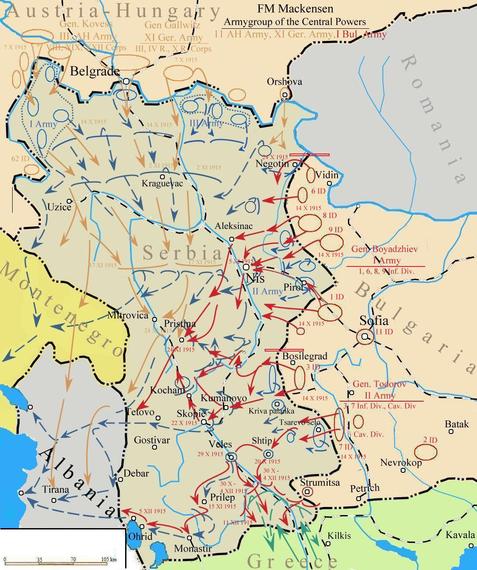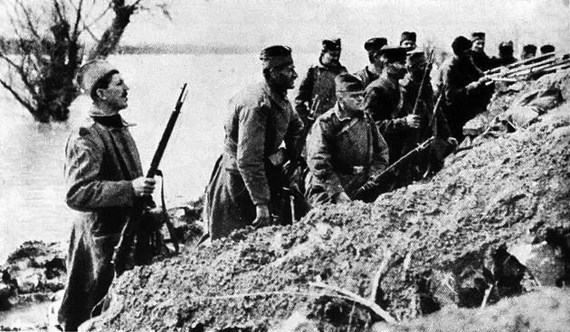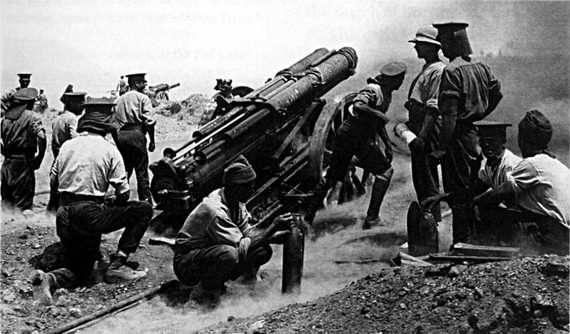The Second Serbian Campaign: October-December 1915
The first Serbian campaign commenced on July 29, 1914. The previous day, in response to what it believed was the Serbian government's culpability in the assassination of the Austrian heir, Archduke Franz Ferdinand, Austria-Hungary had declared war on Serbia.
Although Austro-Hungarian troops would not actually cross the border, the Drina River, until August 12, long after the commencement of fighting along the Western Front, they immediately began an artillery bombardment of the Serbian capital, Belgrade. This was the opening conflict of World War I.
Initially Austria-Hungary committed roughly half of its then available military strength, the Second, Fifth and Sixth Armies, to the invasion of Serbia. The Austro-Hungarian force numbered approximately 500,000 men of which some 378,000 were combat troops. The Serbian force numbered around 250,000.
The Austrian armies, however, especially the Fifth and Sixth Armies, were far better equipped, had more modern artillery and machine guns. On the other hand, a quarter of the invading force was illiterate and most of the troops, a polyglot collection from throughout the Austro-Hungarian Empire, did not speak or understand either German or Hungarian.
The Serbian Army had depleted its supplies during the Balkan War of 1913 with Bulgaria. Its troops lacked uniforms and boots and were chronically short of ammunition. The Serbian mobilization had called up virtually every Serbian male of military age. As the war progressed, replacements would have to come from underage youth and the old.
Despite the numerical odds, the Austro-Hungarian armies were defeated in the Battle of Cer, from August 15-24, and were forced to retreat back across the Drina River. Serbian casualties were approximately 20,000 killed or wounded. The Austrians lost approximately 40,000 men and had another 4,500 taken prisoner. The victory was the first Allied victory of the war. It also marked the first case of an aerial dogfight in World War I.
At the urging of the Allies, in the hope of slowing the transfer of Austro-Hungarian troops to the Eastern Front, the Serbian Army crossed the Stava River and invaded the Austrian region of Syrmia in the northwest. Austrian troops responded, on September 7, by again crossing the Drina River from Bosnia and forced Belgrade to withdraw its troops back to Serbia.
The resulting Battle of Drina lasted, on and off, from September 7 through October 4, after which it turned into a month of trench warfare. The Serbs, lacking artillery and discovering that what little they had was largely obsolete, found themselves at a distinct disadvantage and suffered steadily rising losses.
Austrian forces re-commenced their offensive on November 5, pushing the Serbian army steadily east and capturing Belgrade on December 2. Armed with newly received artillery ammunition from Greece and France, Serbian forces counterattacked the next day. The Battle of Kolubara lasted for 12 days of fierce fighting, eventually, the Austro-Hungarian line broke and the troops retreated once again across the Drina back into Bosnia.
The Serbian Army lost around 170,000 men, killed, wounded or captured, while the Austrian Army lost 215,000 men. The Serbian losses amounted to almost half of its military strength while the Austrian-Hungarian Empire, with twelve times the population of Serbia, was in a far better position to replace its losses.
In February of 1915, Erich von Falkenhayn, Chief of the German General Staff, urged the Austrians to renew their Serbian offensive in order to capture the Serbian portion of the Berlin to Constantinople railroad. The railroad would allow a more direct resupply route to the Ottoman military.
 Austrian Army (tan arrows) and Bulgarian Army (red arrows) and Serbian Army (blue arrows), October-December 1915
Austrian Army (tan arrows) and Bulgarian Army (red arrows) and Serbian Army (blue arrows), October-December 1915
Vienna had mixed feelings about aiding its long-standing rival for control of the Balkans, however. Its concern with Russian forces on the Eastern Front, and the entry of Italy on the side of the Allies in the south, further constrained Austria's freedom of action.
When the war started, both the Allies and the Central Powers had attempted to persuade Bulgaria to enter the war on their side. Long-standing rivalries between Bulgaria and Serbia dating back to the Serbian-Bulgarian war in 1885 and the Second Balkan War in 1913, plus the defeat of Allied forces at Gallipoli, and of Russian forces at Gorlice, finally prompted Bulgaria to enter the war on September 23 on the side of the Central Powers.
On October 7, 1915 a combined Austrian and German force crossed the Drina and Sava rivers and rapidly advanced towards Belgrade. By October 9, following heavy fighting, Belgrade had fallen and the Serbian Army had retreated to the southeast. Less than a week later, on October 14, Bulgarian armies simultaneously attacked from the northeast driving on Nis and from the southeast driving on Skopje.
The Bulgarian First Army defeated the Serbian Second Army at the Battle of Morava, from October 14 through November 9, while the Bulgarian Second Army defeated the Serbs at the Battle of Ovche Pole. Its line shattered, and with the Bulgarian seizure of the rail line to Thessaloniki cutting off any hope of a Greek or Allied intervention, the Serbian Army had no choice but to preserve its remaining strength and retreat to the southwest.
Less than 155,000 men were able to reach the Albanian port of Durazzo. Allied ships completed the evacuation of the remnants of the Serbian Army on February 19, 1916. The Serbian Army eventually joined British and French forces on the Salonika Front in Greece.



